
 |
Eager Space | Videos by Alpha | Videos by Date | All Video Text | Support | Community | About |
|---|

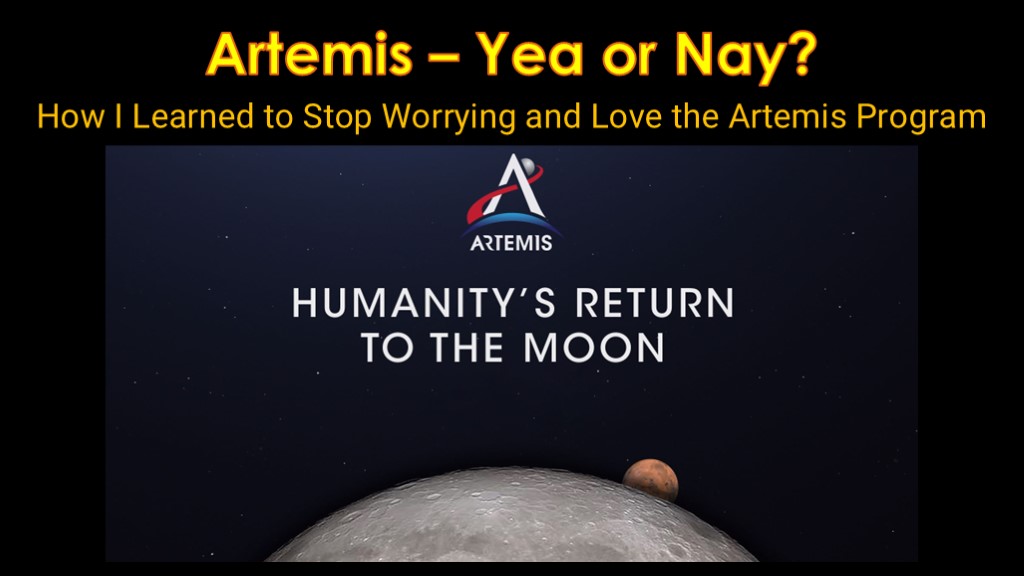
Is Artemis a good idea or a bad idea?
Welcome to Artemis Yea or Nay?
Or How I learned to stop worrying and love the artemis program.
Links:
Why we have the SLS - https://www.planetary.org/articles/why-we-have-the-sls
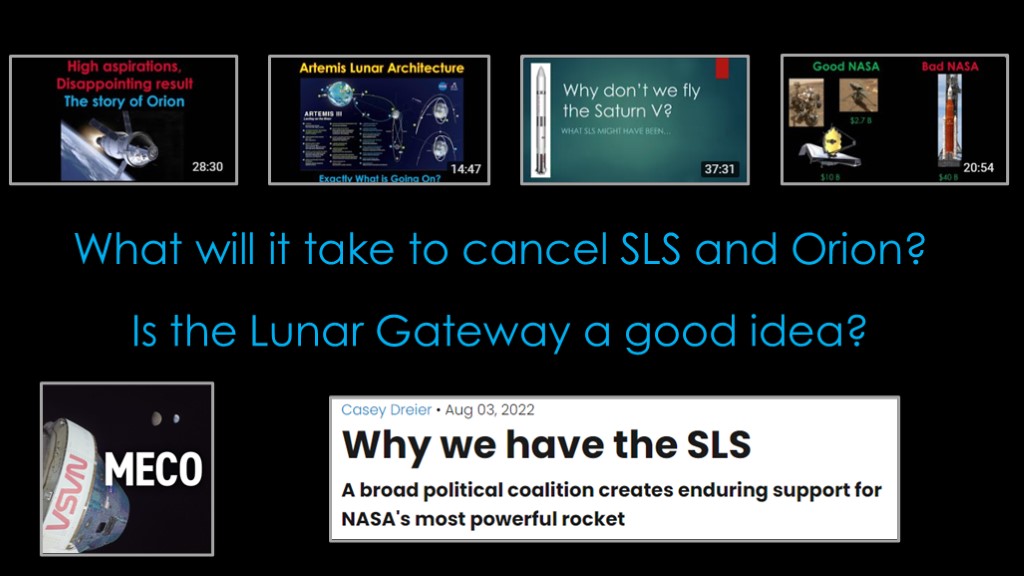
I'll start by confessing that I'm a bit surprised at my opinion on this topic.
I've been pretty clear on what my opinion of SLS and Orion is in a number of my videos.
But I've recently been working on two topics.
The first is "what will it take to cancel SLS and Orion?", and the second topic is "Is the lunar gateway a good idea?".
As often happens, I worked on both of them for a while and put them aside.
Then in early December, I was listening to Anthony Colangelo's excellent Main Engine Cutoff podcast, and he was talking to Casey Dreier from the planetary society, and that led to an article that Casey wrote in early August.
And let me explain my new perspective.
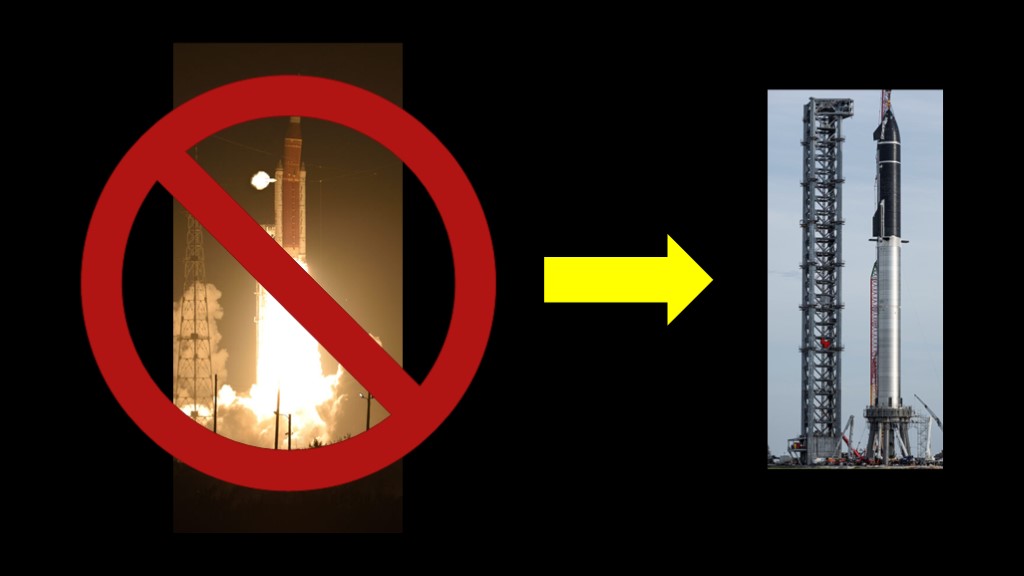
I'm going to start with what seems to be a very common assertion about the Artemis program.
This assertion is a failure on an Artemis mission will lead to the program being cancelled.
And some also assert that the cancellation will lead to SLS and Orion being replaced by Starship.
What evidence is there that this would happen?
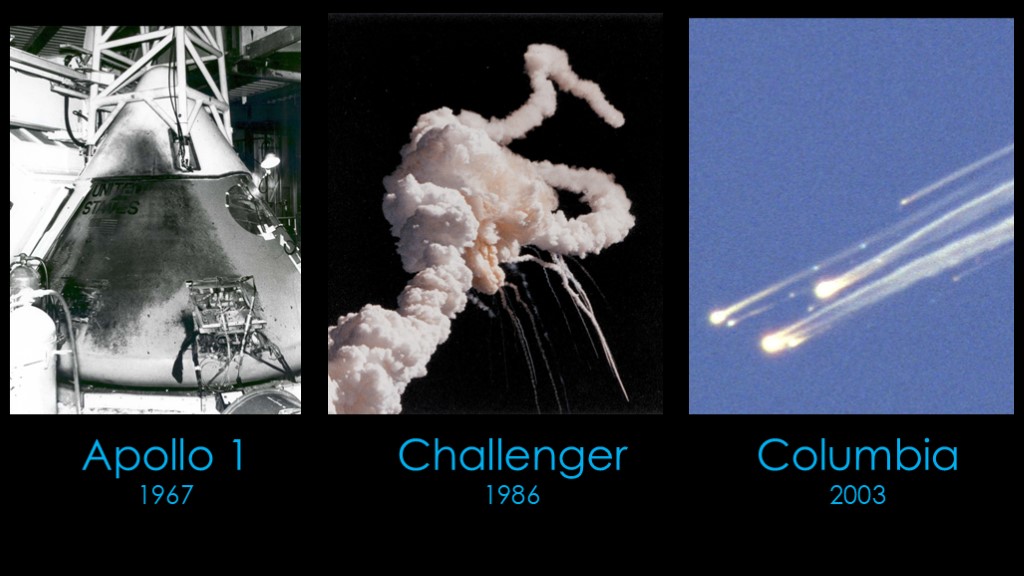
We have three historical examples to look at:
In 1967, three astronauts were killed in the Apollo 1 fire during a test on the pad. Congress held hearings to investigate the causes and were unhappy about the poor management of Apollo but allowed the program to continue.
In 1986, the space shuttle challenger blew up during ascent and 7 astronauts were killed. NASA commissioned an investigational panel, and congress held hearings. Congress was unhappy about the decisions that NASA made when deciding to fly on that cold January day, but allowed the program to continue.
In 2003, the space shuttle Columbia broke up on reentry and 7 astronauts were killed. NASA commissioned an investigational panel, and congress held hearings. It was no surprise that congress was unhappy about the decisions that NASA made in managing the foam-shedding problem, but allowed the program to continue.
I think we've established what to expect from congress when NASA programs kill astronauts.
At this point, some of you are saying that Columbia led to the cancellation of shuttle. I believe that is an overly-simplistic view; the seeds of cancelling shuttle came from the Vision for Space Exploration program announced by president bush in 2005, and it is was the fact that there wasn't enough budget to support both shuttle and the constellation program the led to the cancellation.
For those of you who disagree, I'll only note that shuttle flew 22 times over 7 years after Columbia. If that's a cancellation, it's certainly a very protracted one.
The reality is that the support of congress for NASA programs is not significantly influenced by the success of the program or deaths that occur during the program.
But perhaps Apollo and the Space Shuttle were more popular with congress than SLS and Orion are?
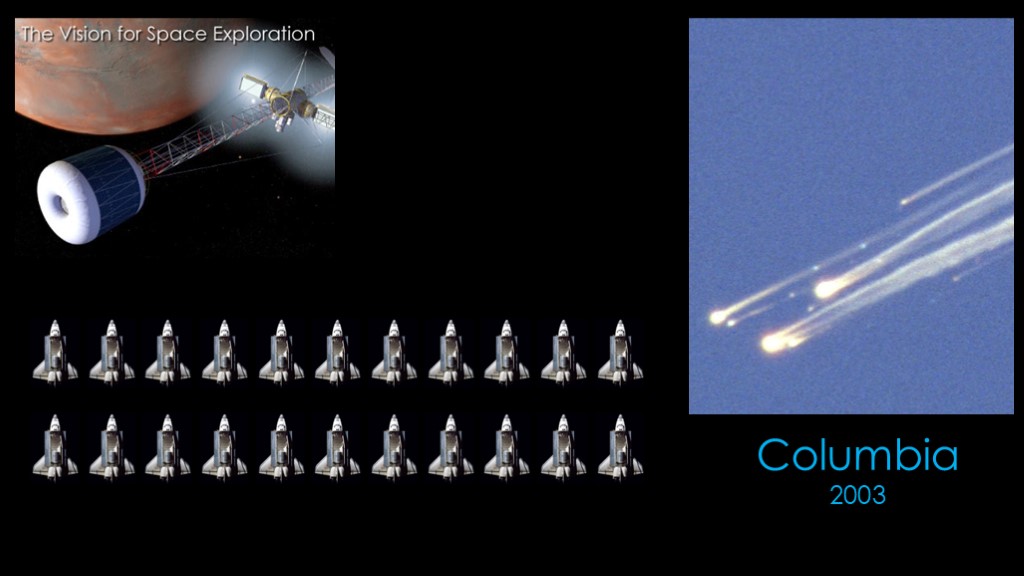
At this point, some of you are saying that Columbia led to the cancellation of shuttle. I believe that is an overly-simplistic view; the seeds of cancelling shuttle came from the Vision for Space Exploration program announced by president bush in 2005, and it is was the fact that there wasn't enough budget to support both shuttle and the constellation program the led to the cancellation.
For those of you who disagree, I'll only note that shuttle flew 22 times over 7 years after Columbia. If that's a cancellation, it's certainly a very protracted one.
The reality is that the support of congress for NASA programs has not been significantly influenced by failures or deaths that occur during the program.
But perhaps Apollo and the Space Shuttle were more popular with congress than SLS and Orion are?
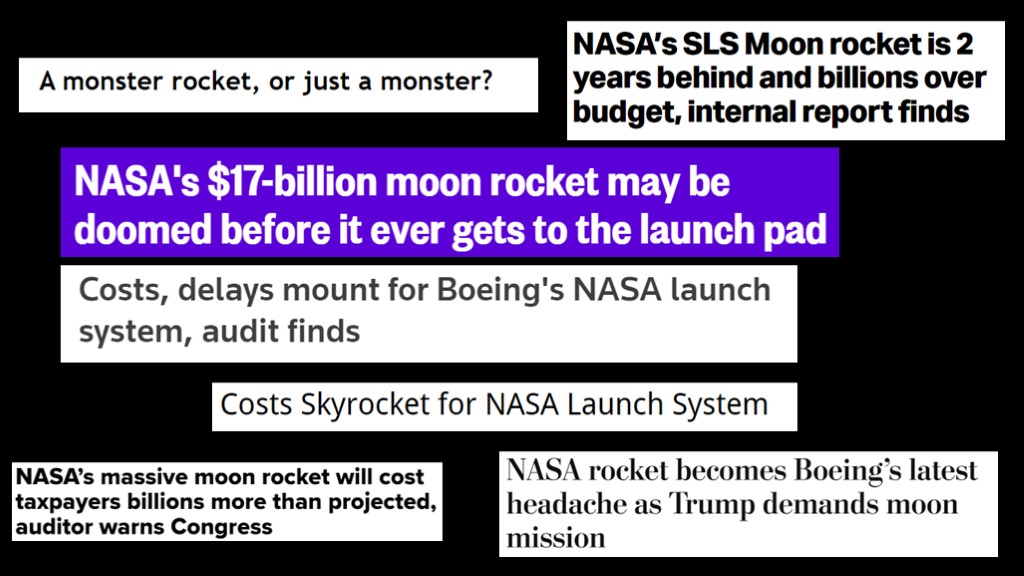
Let's look at some articles that have been written about SLS during its development...

And how did congress react?
You will not be surprised that congress held hearings and allowed the program to continue. But they actually did more than that...
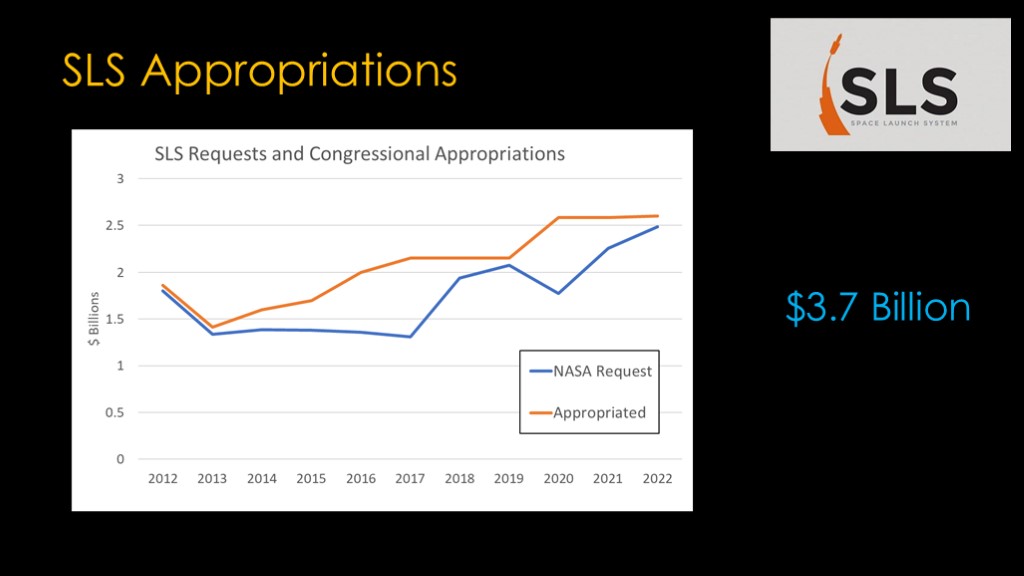
If we look at the money side,
Congress has appropriated more money for SLS than NASA requested every single year since the start of the program. That is despite the reports of poor contractor performance and years of delays, despite changes in administrations, and despite a global pandemic. In total, they've given $3.7 billion extra beyond the NASA requests.
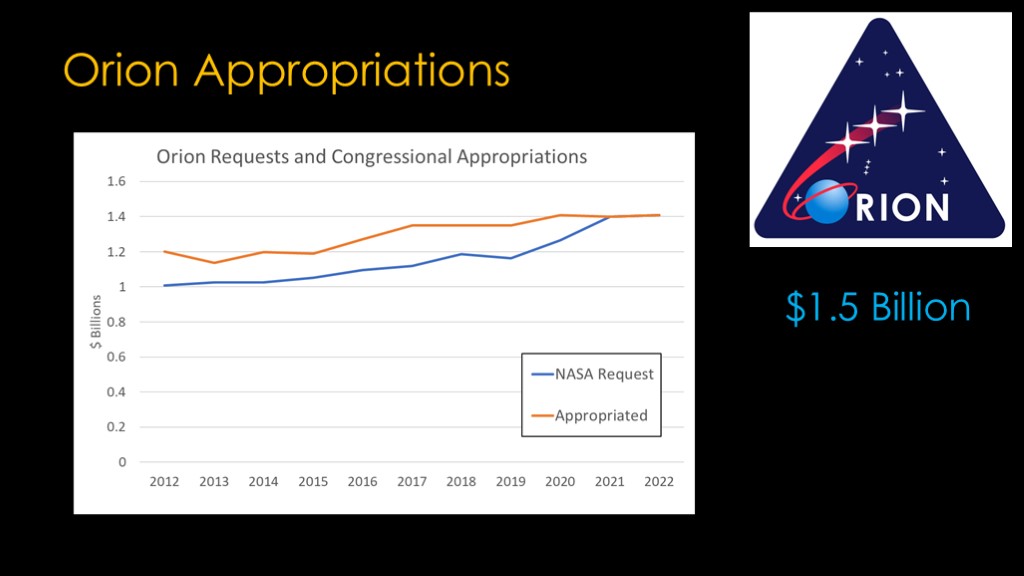
The pattern is similar for Orion - the money appropriated exceeds the request every year except for the last 2, and since 2012, that has added up to an extra $1.5 billion.
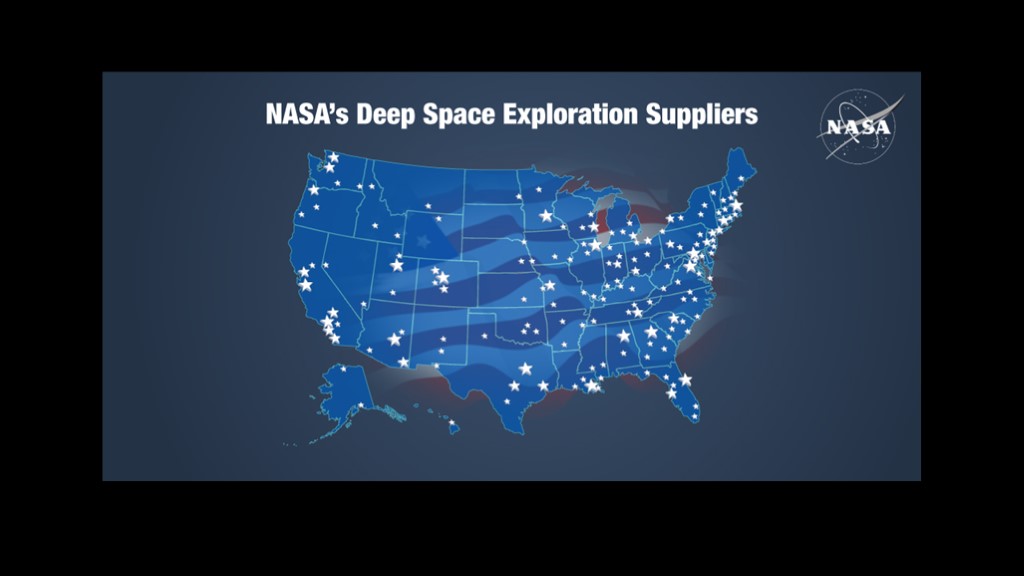
Money from SLS and Orion go to contractors and subcontractors across the country. This is one of the reasons that there is widespread support for the program in congress - one of the roles of congresspeople is to support things that are good for their constituents.
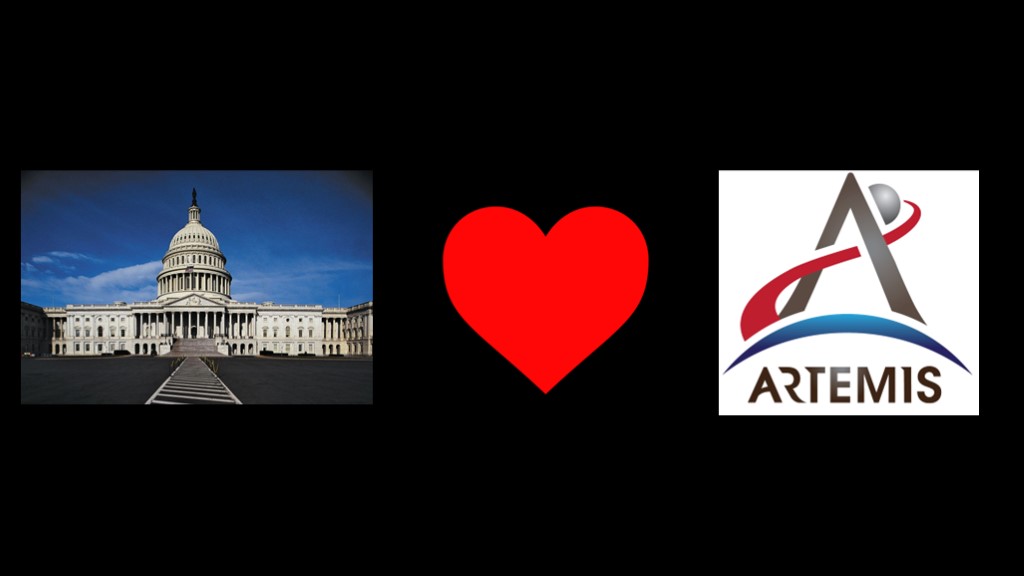
To summarize, congress loves the artemis program.
When I was working to figure out a scenario where congress cancels SLS and Orion, I couldn't come up with a reasonable one. It just isn't going to happen.
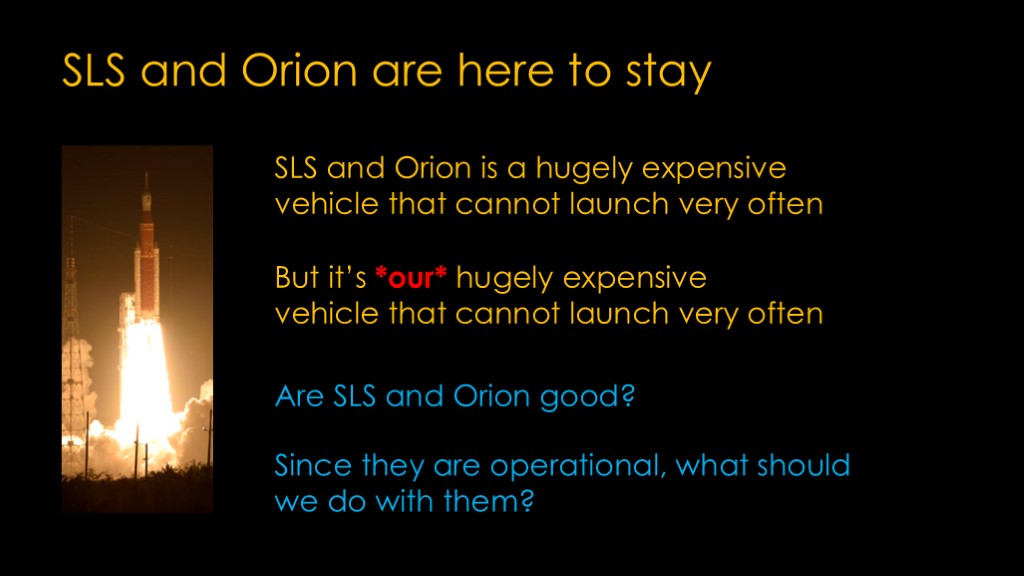
What we need to realize is that SLS and Orion are here to stay. Not in the "next 5 years" timeframe, but in the "10 years" timeframe, and perhaps much longer. Shuttle ran *30* years.
It's certainly true that SLS and orion is a hugely expensive vehicle that cannot launch very often.
But it's *our* hugely expensive vehicle that cannot launch very often.
I was originally working to answer the question "Are SLS and Orion good?", but it turns out that that's not a very interesting question.
The interesting question to ask is, "since they are operational, what should we do with them?"
What can we do with the capability of launching Orion to lunar orbit, and when SLS Block 1B comes along, Orion plus something else heavy to that same orbit?
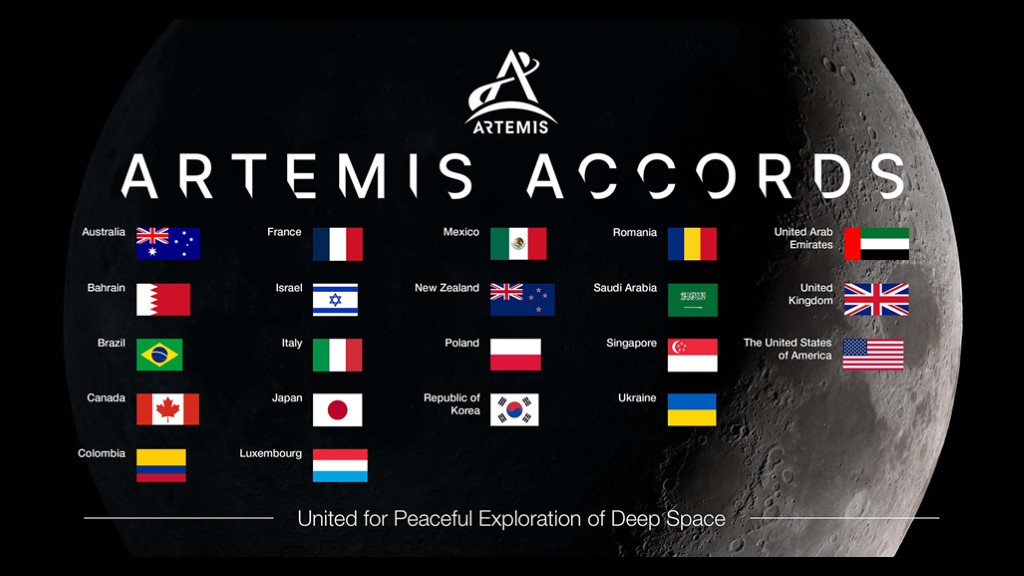
It turns out that NASA has a plan and I am now convinced it's a pretty good one.
The Artemis accords are an attempt to extend the agreements that worked so well for the international space station to exploration of the moon and beyond.
On the surface, they are merely about agreeing to a common framework that guides space exploration.
That's good, because it makes the barrier to entry low; over half of the signatories of the accords have no real space program. So why are they interested in agreeing to accords that apply to things they aren't doing?
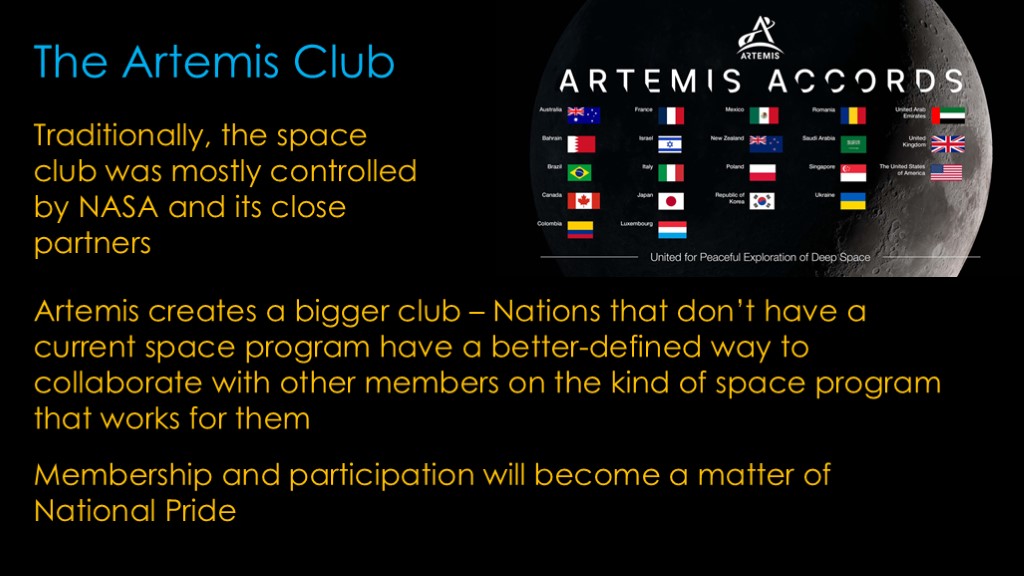
The real point is for them to join the artemis club.
Traditionally, the space club was controlled by NASA and its close partners, the Russians, and more recently the Chinese.
The artemis accords create a bigger club - nations that don't have a space program have a well-defined way to collaborate with others on the kind of space program that works for them.
There's also something equally important going on.
Being part of the artemis club and participating in missions will become a matter of national pride; it's much more difficult to cancel a mission where the US is collaborating with other countries than one that we are doing by ourselves.
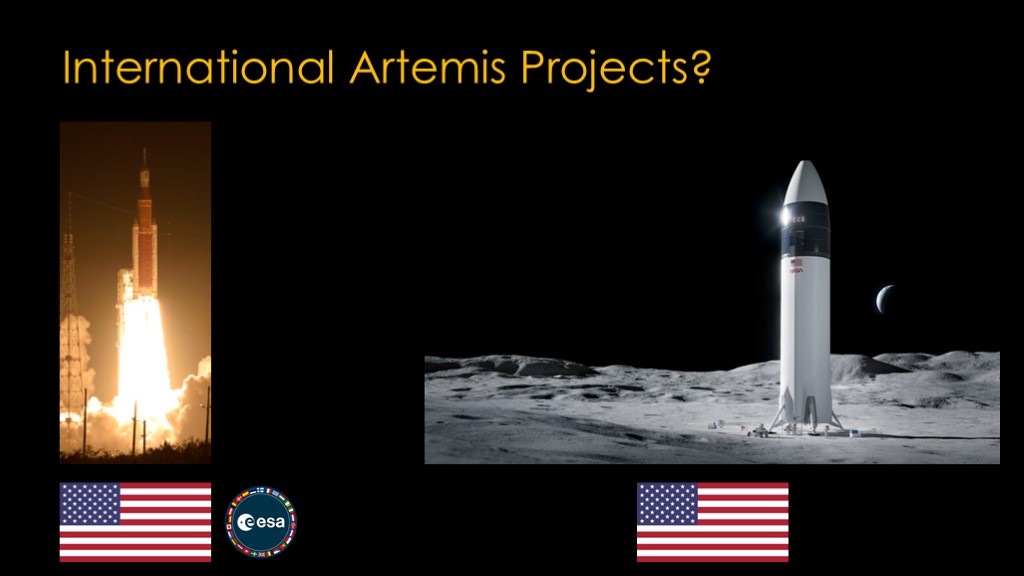
But there's a problem... The current Artemis lunar architecture has only two components.
There's SLS and Orion, which is dominated by the US, with an assist from the european space agency, who supplies the orion service module.
And there's the Starship Lunar lander, a purely US project.
What is needed is a international project that the members of the Artemis club can meaningfully contribute to.
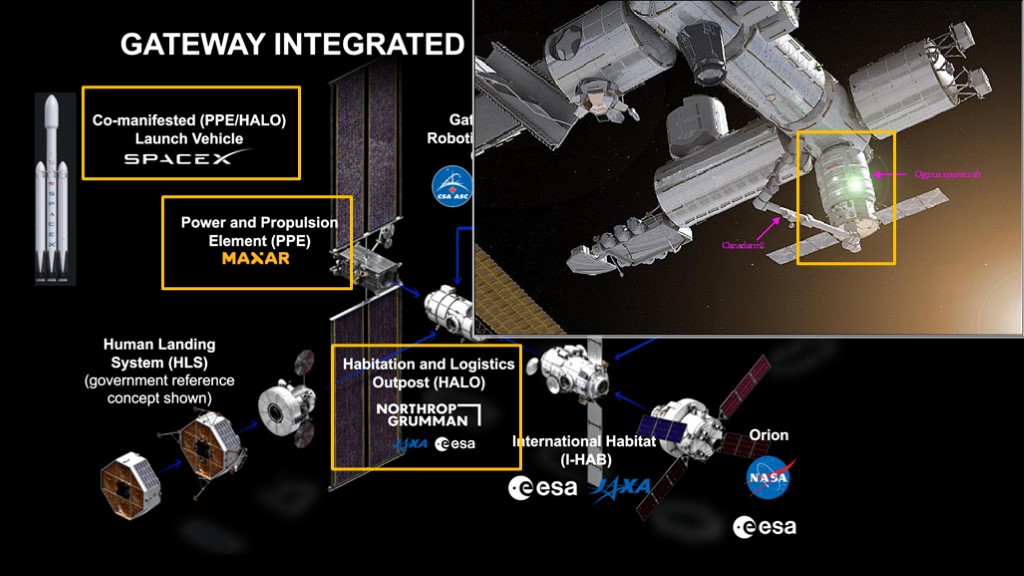
Bring on the Lunar Gateway...
Gateway is a *small* space station, composed of three main modules
There is the US-created power and propulsion element, which - not surprisingly - provides power to the gateway and propulsion to keep it in the proper orbit.
There is the habitation and logistics outpost module, produced by Northrop Grumman in cooperation with the Japanese Space Agency JAXA and the European Space Agency ESA. The module is based on the Cygnus resupply module currently in use with the international space station; you can see from this render how small the gateway modules are in comparison to the ISS modules; they are 3 meters in diameter instead of the ISS 4.5 meters.
These first two modules will be launched by a Falcon heavy in November of 2024.
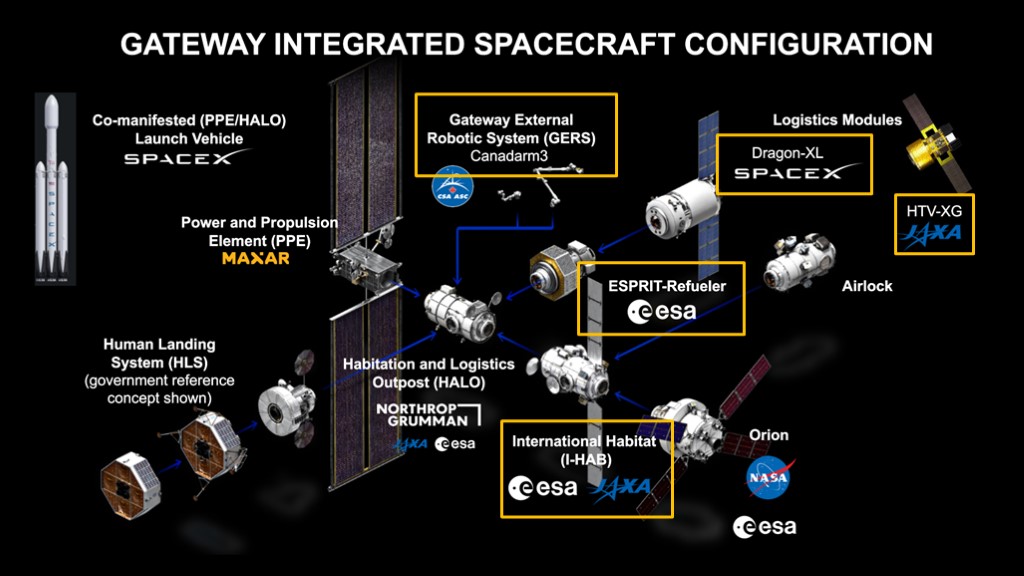
Added to that is the international habitat module from JAXA and ESA, launched on the first SLS block 1B rocket, currently expected to be Artemis 4.
Canada will supply the newest version of their robotic arm, the Canadarm 3.
Next up is the European Esprit module, which provides refueling, infrastructure, and communications. The communications part will launch with the PPE and HALO modules in 2024, and the remainder is scheduled for 2028.
Logistics will be provided by the Dragon-XL, though that contract is still a bit up in the air, and also by the HTV-XG, an updated version of the HTV resupply module used with the ISS.
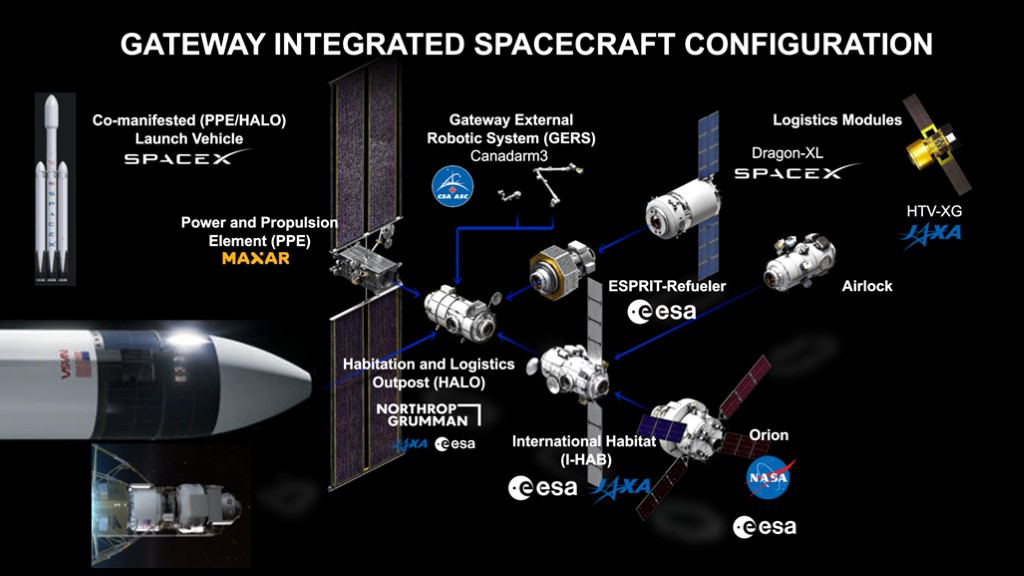
And of course it is expected that the human landing system will dock with gateway and it will be used to transfer astronauts from Orion to the lander. This will initially be the lunar variant of starship, and perhaps later a second lander from the winner of NASA's current SLD program.
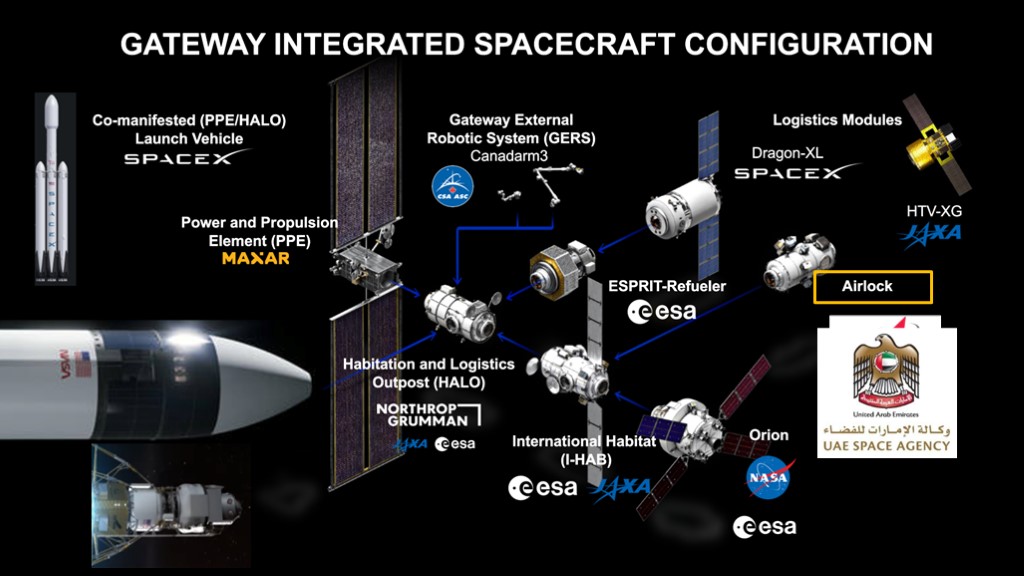
Which leaves us with the airlock.
The airlock was originally going to be provided by ROSCOSMOS, but in 2020 they decided that the Artemis program was "too US-centric" and withdrew.
That left the airlock unbuilt, but NASA announced in December of 2022 that it will be provided by the united arab emerites space agency, which is the first large contribution to artemis by a country that was not part of ISS.
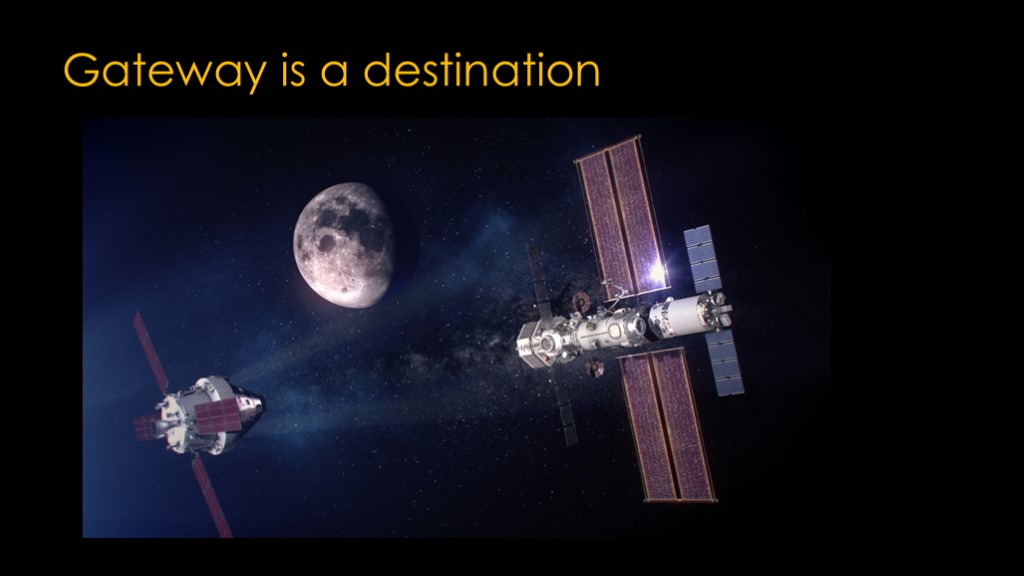
The important part of gateway is that it provides a long-lived destination. It will be the central US point for missions to the moon.
SLS can carry people to gateway, and with block 1B it can carry people and gateway modules or supplies to gateway.
Gateway is not currently envisioned as a continuously crewed station the way ISS is, because the current flight rate of SLS and Orion only supports short missions. This is analogous to the situation with shuttle, where for many years it was the only US launcher to get to the ISS, but then it retired and Crew Dragon and Starliner came along. One can easily see a similar thing happen with gateway in the future.
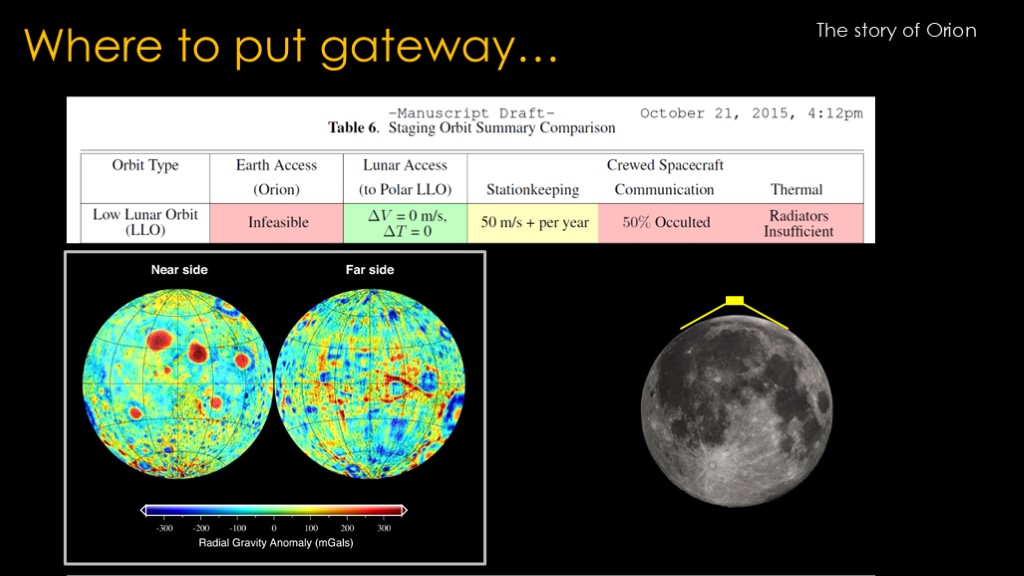
If you are going to build a lunar space station, you need to choose an orbit for it.
Here's a nice little chart that explores different orbits.
The most obvious one to use is low lunar orbit, the orbit used by Apollo. It's a non-starter in this case because Orion doesn't have the delta-v to get into and out of this orbit - see my video on the story of orion to find more details - but low lunar orbit isn't a great place for a station.
The moon has a number of mass concentrations - or mascons - and those perturb - or mess up - low lunar orbits. You can get back to the orbit you want using thrusters, but that requires fuel. The low lunar orbit takes about 50 meters per second of delta v per year to stay in the proper orbit.
Another issue for a space station is that you would like to use it for communication with the surface and perhaps for remote operation of robotic systems, but a station in low lunar orbit can only communicate with a small portion of the lunar surface at any one time.
These are significant disadvantages for a station in low lunar orbit, even if orion could get there.
https://en.wikipedia.org/wiki/Gravitation_of_the_Moon#/media/File:MoonLP150Q_grav_150.jpg
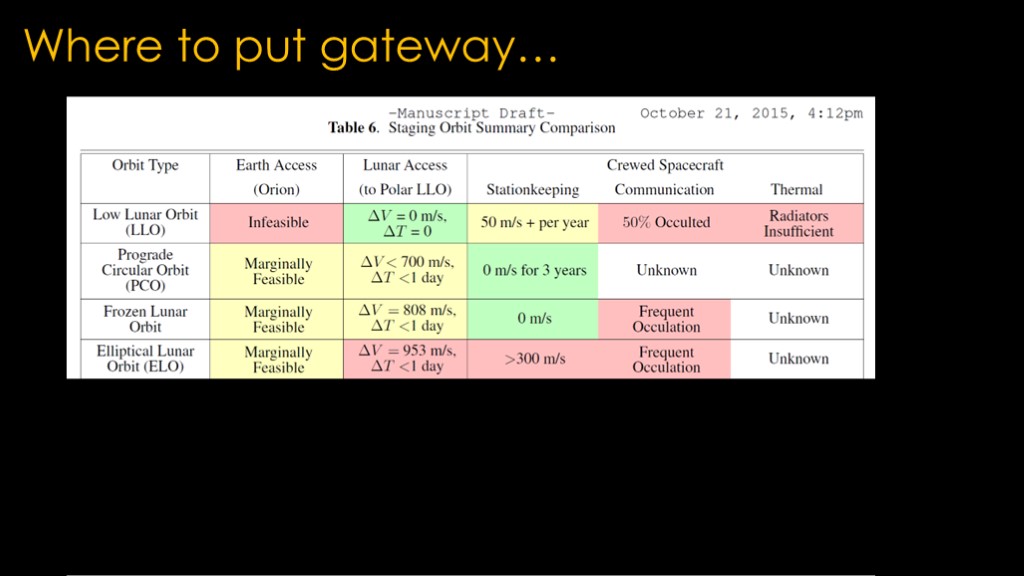
There are some other options that Orion could maybe get to.
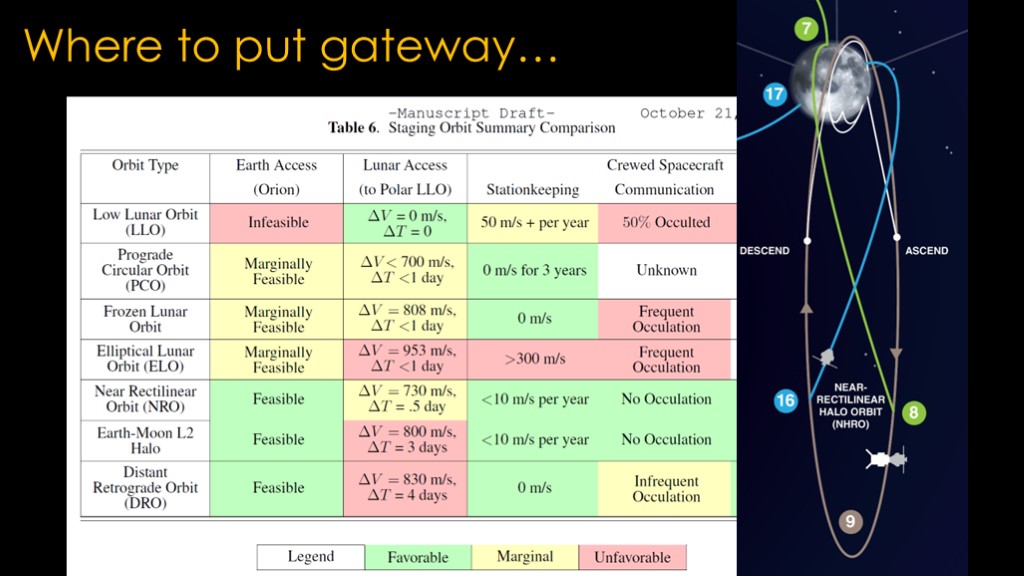
But the ones we care about are the ones Orion can get to. Of these three, the near rectilinear halo orbit is the best choice; it's decently close to low lunar orbits for landing and it has much lower delta-v requirements to stay in the proper orbit.
And because the orbit is very elliptical, it spends most of its time with a great view of the southern hemisphere of the moon and is only out of communication for the short time when it is close to the moon.
And that's why NASA chose that orbit for the gateway.
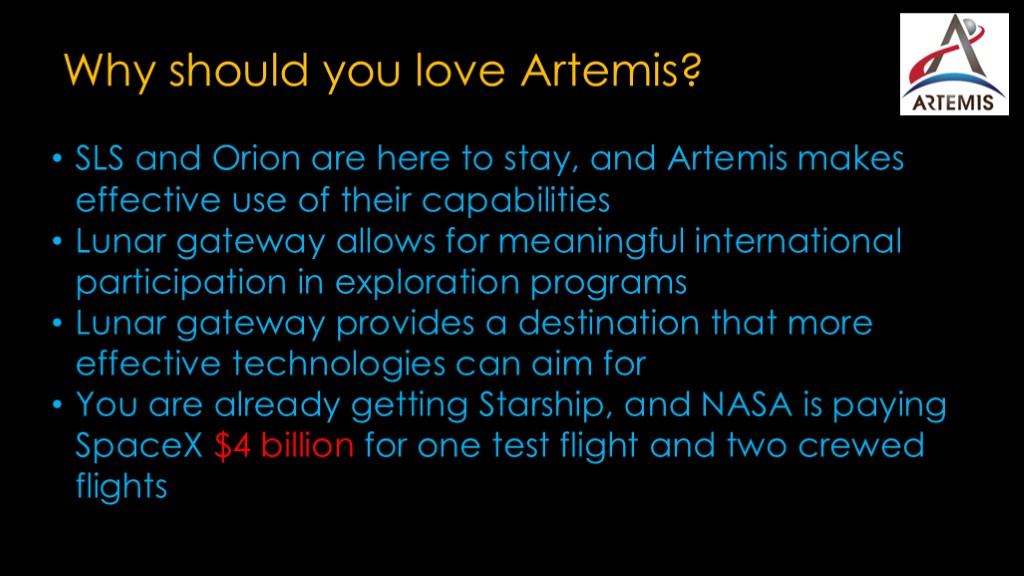
Why should you love artemis?
SLS and Orion are here to stay, and Artemis makes effective use of their capabilities
Lunar gateway allows for meaningful international participation in exploration programs and a common forum for other space-related activities. This makes it more likely that the things that we want to happen will happen.
Lunar gateway provide a destination that more effective technologies can aim for. Want to do lunar commercial crew? Provide a way to get to gateway.
And finally, you are already getting starship, and NASA is paying $4 billion for one test flight and two crewed flights.
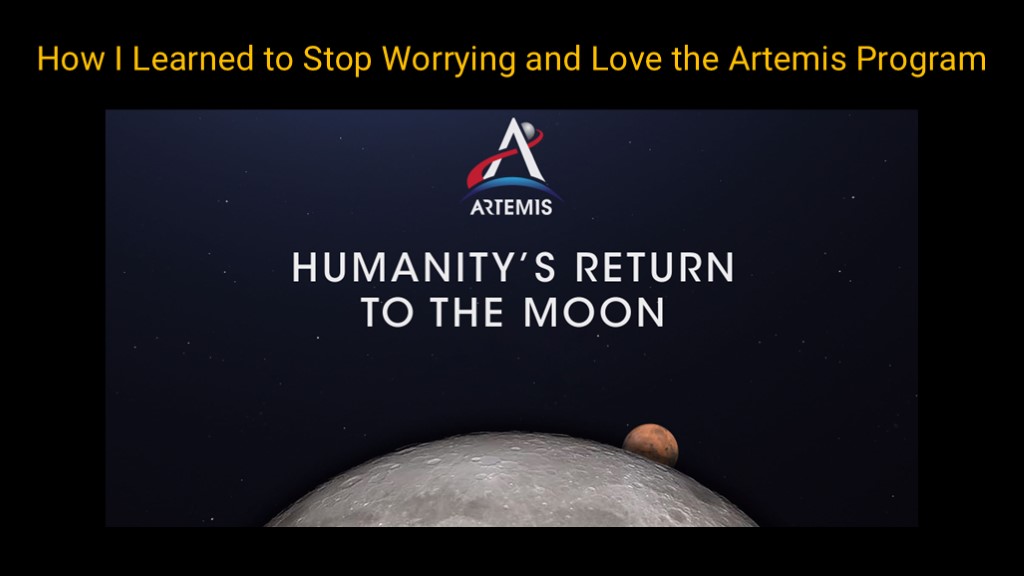
And that's how I learned to stop worrying and love the artemis program

A quick channel announcement - Teller's Tachyon Tablets has asked me to make some merch available for their product, so you can get a very attractive sticker or a t shirt with the tablet box on the front and the "Climbing Spaceman" on the back.
If you go to the channel page you can find them on the "store" tab.

If you enjoyed this video, please watch Doctor Strangelove

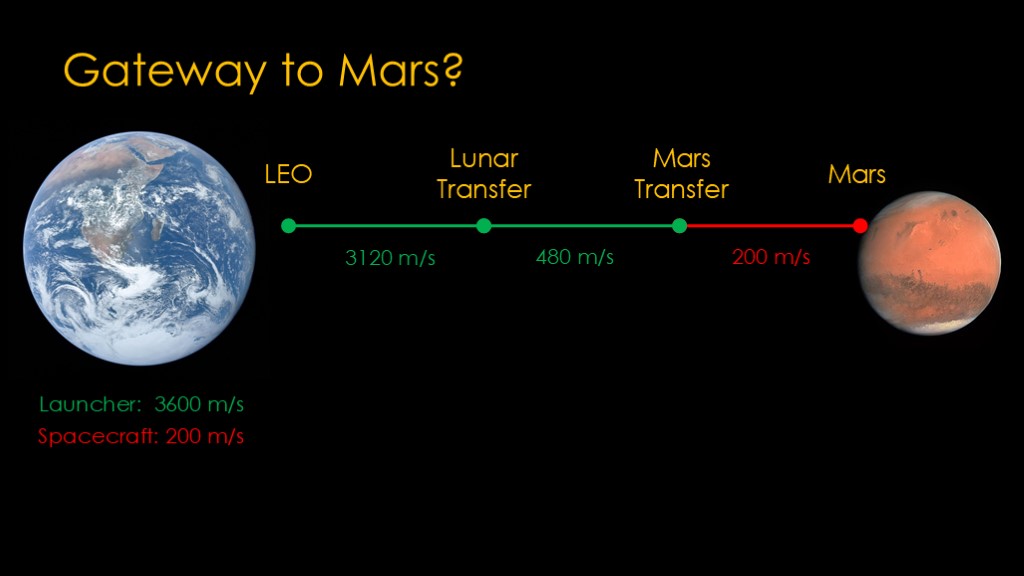
We'll start by talking about Mars.
The first stage of our trip to Mars starts in low earth orbit and goes to lunar transfer orbit. It takes about 3100 meters per second of delta v, and it's pretty quick - just a day or two. The next stage is from lunar transfer to mars transfer. It's a little less than 480 meters per second of delta V.
Both of these are generally handled by the launch vehicle, for a total of 3600 meters per second of delta V.
Once we reach this point, the gravity of Mars will accelerate the spacecraft towards the planet. Most missions scrub off this excess velocity using aerobraking, and spend a small amount of delta v - say 200 meters per second - slowing down for the landing. Simple, and pretty cheap in terms of delta v - one of the reasons NASA has done so many missions to Mars.
Checkout, refueling
Draw delta-v map between LEO and mars plus showing the travel times.
This not only makes your job harder, it's a bit like driving to the hotel at the airport to spend the night before you head off to Hawaii.
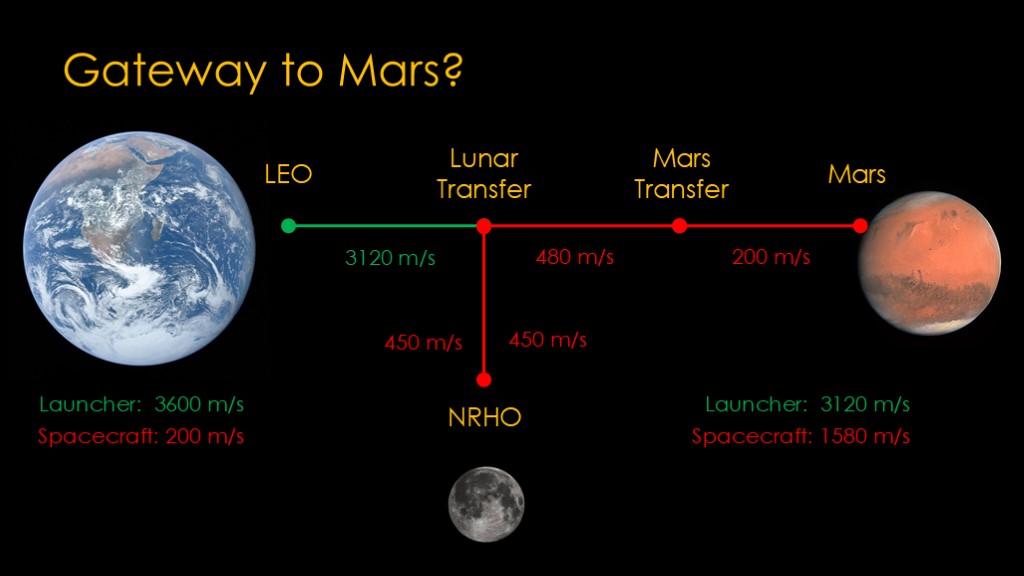
How does that change if we stop by the lunar gateway on the way to Mars?
We will still start by going to the lunar transfer point, and then we will head into the near rectilinear halo orbit used by the gateway. That will take about 450 meters per second of delta v, and because we are slowing down, that delta v can only be provided by the spacecraft.
After doing whatever we wanted to do at the Gateway, we need to head back to the lunar transfer point, spending another 450 meters per second of delta v.
From there, it's off to Mars, with the delta-v of 480 meters per second, all supplied by the spacecraft, and then the same aerobraking approach to mars.
If we look at the totals, this approach is easier for the launcher, with only 3120 meters per second required. But it's much, much worse for the spacecraft, going from 200 meters per second all the way up to 1130 meters per second.
The original spacecraft could get by with only about 7% of its mass devoted to fuel.
The gateway visitor version needs about 40% of its mass devoted to fuel. That means it's quite a bit heavier. And since the overall spacecraft is heavier the reduction in the required delta v from the launch vehicle is likely eaten up by the extra weight.

What is the impact of these differences?
Here's one example. It assumes we are starting from low earth orbit to make the example simpler, though in most cases missions would not stop off in low earth orbit.
We are going straight to mars, and our spacecraft needs 200 meters per second of delta v. Its total mass is 40 tons. Of that 40 tons, only 3 tons are devoted to propellant, and there are 37 tons to devote to everything else. This is good.
Our earth departure vehicle is 15 tons dry and carries 70 tons. It can send our spacecraft out with 3620 meters per second of delta v, which is enough to get us to Mars.
If we stop by gateway, our spacecraft now needs 1580 meters per second of delta v. To get that out of our current spacecraft, we need to add 23 tons of propellant, pushing our mass up to 63 tons total. Our launch vehicle only needs to give us 3120 meters per second of delta v to get to mars, but unfortunately the huge increase in mass of the spacecraft means it can only give us 2851 meters per second. That's nto enough to get to Mars.
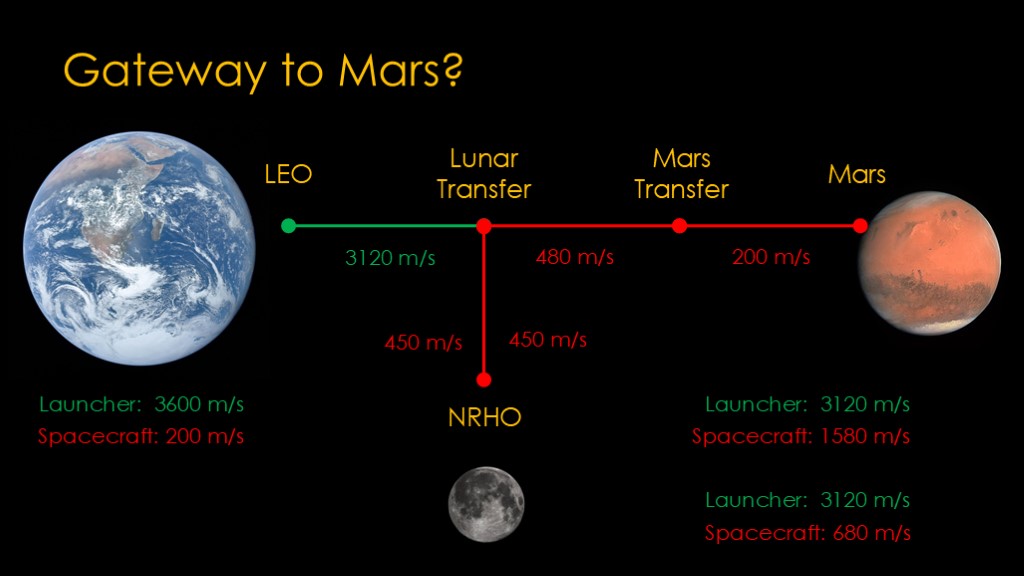
One argument for stopping by gateway is that it's a short trip and the crew can verify that their spacecraft is behaving itself before heading on the 6 month journey to Mars.
This is true. But there's nothing magic about gateway. If we want that option we can simply use the same approach with a launch to lunar transfer orbit by the launch vehicle. If something isn't right, just turn around and head back home. If things are fine, do another burn to head off to Mars.
That skips the 900 meters per second of delta V to get to gateway and back, dropping the spacecraft delta v down to 680 meters per second.